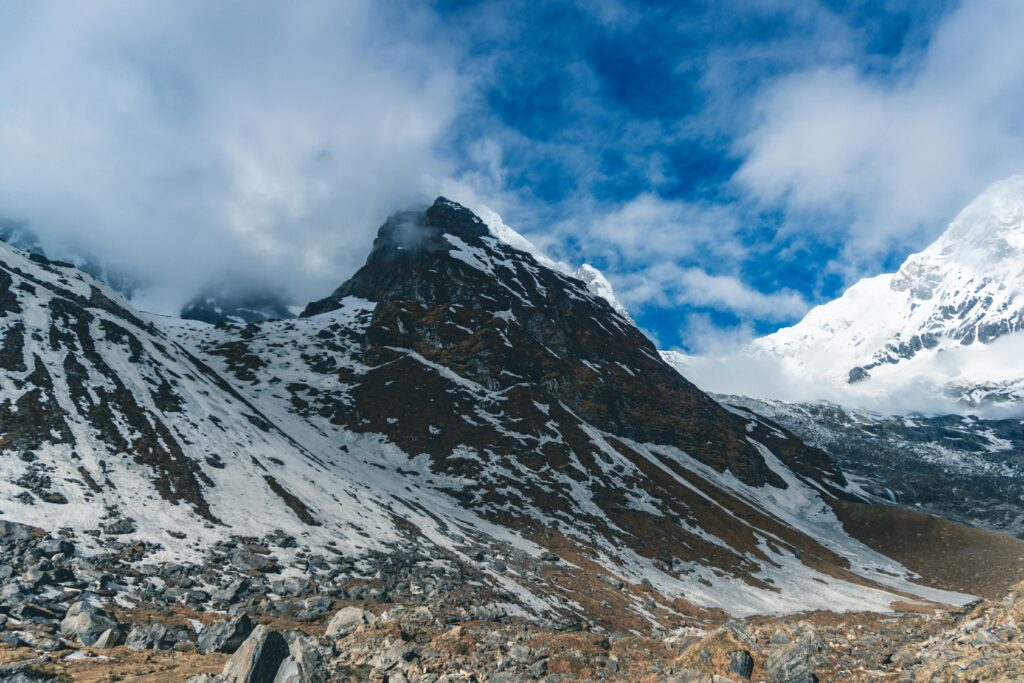Overview
The Everest Base Camp (EBC) trek is one of the most iconic and sought-after trekking adventures in the world. Located in the heart of the Himalayas in Nepal, this trek brings adventurers close to the world’s highest peak, Mount Everest (8,848 meters/29,029 feet). The journey to EBC not only offers breath-taking views of Everest and its neighbouring peaks but also provides a deep immersion into the culture and lifestyle of the Sherpa people who inhabit this region.

Trekking Route
The classic Everest Base Camp trek typically spans 12-14 days, starting and ending in the town of Lukla. Here’s a day-by-day breakdown of the trek:
Day 1: Arrival in Lukla and Trek to Phakding
- Flight: Kathmandu to Lukla (2,860 meters/9,383 feet)
- Trek: Lukla to Phakding (2,610 meters/8,563 feet)
- Distance: 8 km (5 miles)
- Highlights: Scenic flight into Lukla, a short trek to ease into the journey, crossing several suspension bridges over the Dudh Koshi River.
Day 2: Phakding to Namche Bazaar
- Elevation: 2,610 meters (8,563 feet) to 3,440 meters (11,286 feet)
- Distance: 10-12 km (6-7.5 miles)
- Highlights: Entering Sagarmatha National Park, breathtaking views of Everest and Lhotse, arrival at the bustling Sherpa town of Namche Bazaar.
Day 3: Acclimatization Day in Namche Bazaar
- Elevation: 3,440 meters (11,286 feet)
- Activities: Short hikes to Everest View Hotel (3,880 meters/12,729 feet) or Khumjung village, exploring Namche Bazaar, visiting the Sherpa Museum.
Day 4: Namche Bazaar to Tengboche
- Elevation: 3,440 meters (11,286 feet) to 3,860 meters (12,664 feet)
- Distance: 10 km (6 miles)
- Highlights: Passing through pine forests, first close-up views of Ama Dablam, visit to the famous Tengboche Monastery.
Day 5: Tengboche to Dingboche
- Elevation: 3,860 meters (12,664 feet) to 4,410 meters (14,469 feet)
- Distance: 11 km (7 miles)
- Highlights: Traversing the Imja Khola Valley, views of the Everest, Lhotse, and Nuptse peaks, arrival at the village of Dingboche.
Day 6: Acclimatization Day in Dingboche
- Elevation: 4,410 meters (14,469 feet)
- Activities: Short hikes to Nagarjun Hill (5,100 meters/16,732 feet) or Chukhung Valley, resting and exploring Dingboche.
Day 7: Dingboche to Lobuche
- Elevation: 4,410 meters (14,469 feet) to 4,940 meters (16,207 feet)
- Distance: 12 km (7.5 miles)
- Highlights: Passing the memorials for climbers who perished on Everest, stunning views of Pumori and Khumbutse peaks.
Day 8: Lobuche to Gorak Shep and Everest Base Camp
- Elevation: 4,940 meters (16,207 feet) to 5,364 meters (17,598 feet)
- Distance: 15 km (9 miles)
- Highlights: Arrival at Gorak Shep (5,170 meters/16,961 feet), trekking to Everest Base Camp, exploring the base camp area.
Day 9: Gorak Shep to Kala Patthar and Pheriche
- Elevation: Kala Patthar (5,545 meters/18,192 feet) to Pheriche (4,371 meters/14,340 feet)
- Distance: 13-15 km (8-9 miles)
- Highlights: Early morning hike to Kala Patthar for sunrise views of Everest, descent to Pheriche.
Day 10-13: Return to Lukla
- Route: Retrace steps back through Tengboche, Namche Bazaar, and Phakding to Lukla.
- Highlights: Enjoying familiar scenery from a different perspective, celebrating the successful trek.
Culture and Scenery
Sherpa Culture: The trek provides a deep cultural experience, with many opportunities to interact with the local Sherpa community. Visitors can learn about their unique customs, traditional lifestyle, and Buddhist practices. Highlights include visiting monasteries, prayer wheels, and witnessing the daily life in villages like Namche Bazaar and Tengboche.
Natural Beauty: The trail offers diverse landscapes, from dense rhododendron forests and glacial rivers to alpine meadows and rocky terrains. Trekkers are treated to panoramic views of some of the highest peaks in the world, including Mount Everest, Lhotse, Nuptse, Ama Dablam, and Thamserku.
Wildlife: The Sagarmatha National Park is home to various wildlife species, such as the Himalayan tahr, musk deer, snow leopards, and a variety of birds, including the colorful Himalayan monal.
Challenges and Acclimatization
Altitude: One of the biggest challenges of the EBC trek is the high altitude. Trekkers must be cautious of altitude sickness and take time to acclimatize properly. Rest days in Namche Bazaar and Dingboche are crucial for adjusting to the thinner air.
Physical Fitness: While the trek does not require technical climbing skills, it demands good physical fitness and stamina. The daily hikes can be strenuous, with significant elevation gains and long walking hours.
Conclusion
The Everest Base Camp trek is a once-in-a-lifetime adventure that offers a perfect blend of natural beauty, cultural immersion, and physical challenge. Standing at the foot of the world’s highest mountain, amidst the stunning Himalayan landscape, is an unparalleled experience that leaves trekkers with lasting memories and a profound sense of achievement.